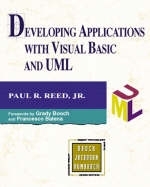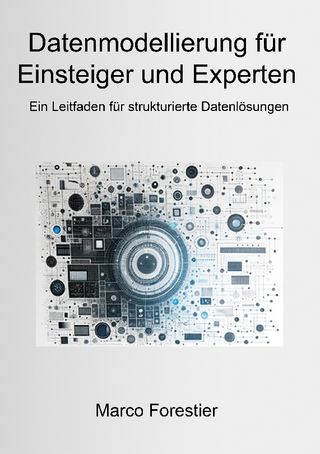
Developing Applications with Visual Basic and UML
Addison Wesley (Verlag)
978-0-201-61579-1 (ISBN)
- Titel ist leider vergriffen;
keine Neuauflage - Artikel merken
An essential resource for Visual Basic (VB) programmers who want to develop applications that are both resilient and robust, Developing Applications with Visual Basic and UML describes a proven development process for designing and implementing object-oriented client/server applications in VB using the Unified Modeling Language (UML). Guided by his own experiences as a developer applying UML and VB, the author provides clear explanations of the fundamentals of UML while also examining and illustrating the often misrepresented object-oriented properties of Visual Basic. In addition, the book incorporates in-depth information on developing VB applications utilizing DNA concepts, incorporating technologies such as DCOM and MTS, and integrating Web tools such as ASP, VB Script, and JavaScript to Internet-enable Visual Basic applications. A significant case study runs throughout the book, leading the reader through the lifecycle of a projectofrom requirements analysis to modeling and prototyping through finalizing the architecture and generating code.
Through this study, the author demonstrates the design benefits of UML and shows how to translate a UML specification into Visual Basic code. The author includes detailed coverage of the following topics: *Uncovering the events for which an application must be responsible *Modeling use cases with UML *Using Rational Rose to manage UML artifacts *Translating the object-based UML class diagram to a relational design supported by SQL Server or Oracle *Transitioning from classes and use cases to the UML's dynamic models, the sequence and collaboration diagrams *Mapping UML to Visual Basic deliverables *Generating code from the UML class diagram *Distributed technology solutions based on Distributed Internet Architecture (DNA) using Distributed Component Object Model (DCOM) and Microsoft Transaction Server (MTS) *Web-enabling VB applications using Active Server Pages (ASP), VBScript, JavaScript, and Microsoft's Visual InterDev With the information and expert techniques presented in this book, readers can significantly enhance their Visual Basic programming skills as well as their overall understanding of how an effective development process impacts the quality of the final application.
0201615797B04062001
Paul R. Reed, Jr., is President of Jackson-Reed, Inc. (www.jacksonreed.com), where he consults on the implementation of object-oriented distributed systems worldwide. He develops and leads seminars on such topics as object-oriented analysis and design, use case analysis, the Unified Process, Internet application development, and client/server technology. Paul also speaks at various industry events, including DB/Expo, UML World, and VBITS, and is the author of numerous journal articles as well as Developing Applications with Visual Basic and UML (Addison-Wesley, 2000). 0201615797AB10302001
1. The Project Dilemma.
Goals.
The Project Dilemma.
The Synergy Process Model.
The Unified Modeling Language.
Checkpoint.
2. Visual Basic, Object-Oriented, and the UML.
Goals.
Visual Basic as an Industrial Strength Development Tool.
Visual Basic and the Concept of Object-Oriented.
Why the UML and Visual Basic?
Checkpoint.
3. Getting the Project Started.
Goals.
Establishing the Project Charter.
Checkpoint.
4. Use Cases.
Goals.
The Sample Project.
The Process Model.
Finding the Pathways through the Use Case.
Shadow Use Cases.
Detailing the Happy Path.
Completed Process Orders Use Case.
Preparing the Preliminary Architecture.
Project Charter: Increments and Estimates.
Checkpoint.
5. Classes.
Goals.
Elaboration Phase.
Detailing Pathways.
Identifying and Categorizing Business Rules.
Uncovering Classes.
Relationships.
Creating the Class Diagram.
Identifying Attributes and Operations.
Object Diagram.
Finishing Up: The Analysis Model.
Checkpoint.
6 Building an Early Prototype.
Goals.
Building an Early Prototype.
Requirements Gathering.
Iteration One.
Checkpoint.
7. The Dynamic Elements of the Application.
Goals.
Next Step of the Elaboration Phase.
Dynamic Modeling.
The Sequence Diagram.
The Collaboration Diagram.
The State Diagram.
The Activity Diagram.
Selecting the Right Diagram.
Non-UML Extensions in the Design: Usage Matrices.
Checkpoint.
8. The Technology Landscape.
Goals.
Next Phase of the Elaboration Phase.
Separating Services.
Logical versus Physical Tiering.
Microsoft's Tiering Strategy.
Managing Transaction Scope within the Application and Microsoft Transaction Server.
Incorporating the Internet into the Solution.
Remulak Productions Execution Architecture.
Checkpoint.
9. Data Persistence: Storing the Objects.
Goals.
Construction Phase.
Object-Oriented and Translating to the Physical Design.
Mapping Classes to Tables.
Mapping Simple Associations.
Mapping Inheritance to the Relational Database.
Mapping Aggregation and Composition to the Relational Database.
Mapping Reflexive Associations to the Relational Database.
Key Structures and Normalization.
Using a Visual Modeling Tool to Generate the Data Definition Language.
Stored Procedures and Triggers and the Object-Oriented Project.
Visual Basic Support of Data-Aware Classes.
The Data Translation Services and Data Access Services Layers.
Checkpoint.
10. Applying the Infrastructure.
Goals.
Construction Phase.
Checkpoint.
11. Generating Code from the UML Class Diagram (Part 1).
Goals.
Construction Phase.
Adding Code to Realize a Use Case Pathway.
Data Access Service Layer: DASVC Component.
Data Translation Service Layer: DTSVC Component.
Business Rule Service Layer: BRSVC Component.
Presentation Service Layer: UISVC Component.
Building Blocks for the Future.
Checkpoint.
12. Generating Code from the UML Class Diagram (Part 2).
Goals.
Construction Phase.
Checkpoint.
13. Creating a Distributed Implementation: DCOM and MTS.
Goals.
Construction Phase.
Remote Solutions-Distributed Component Object Model.
Remote Solutions-Microsoft Transaction Server.
Checkpoint.
14 Alternative Interfaces: The Internet.
Goals.
Construction Phase.
Checkpoint.
Appendix A Estimating Project Using Use Cases.
Actors.
Use Cases.
Technical Factors.
Project Participants.
Use Case Points.
The Project Estimate.
Appendix B Adding Additional Functionality to Rational Rose Data Definition.
Language Capability.
Enhancements-Persistent and Transient Attributes.
Modifying Rational Rose-Persistent Attribute Setup.
Modifying Rational Rose-Running the Definition Script.
Modifying Rational Rose-Changing the Script to Recognize the Attribute.
Other Areas of Change.
Appendix C An Object-Oriented Primer.
What Does Object-Oriented Mean?
Object-Oriented-Right in Your Own Backyard.
By-Products of Object-Oriented.
Inheritance.
Encapsulation.
Polymorphism.
No Silver Bullet.
Appendix D Component Object Model and COM+.
COM-The Plumbing.
COM-Infrastructure.
COM at Work.
Visual Basic-Version Compatibility.
COM +.
Appendix E Object-Oriented Project Plan.
Appendix F Sample Project Output.
Use Cases-Use Case Details for Increment I.
Use Cases-Happy Path Task Steps.
Database Support.
Bibliography.
Suggested Readings.
Index. 0201615797T04062001
| Erscheint lt. Verlag | 24.11.1999 |
|---|---|
| Verlagsort | Boston |
| Sprache | englisch |
| Themenwelt | Mathematik / Informatik ► Informatik ► Programmiersprachen / -werkzeuge |
| Informatik ► Software Entwicklung ► UML | |
| ISBN-10 | 0-201-61579-7 / 0201615797 |
| ISBN-13 | 978-0-201-61579-1 / 9780201615791 |
| Zustand | Neuware |
| Haben Sie eine Frage zum Produkt? |
aus dem Bereich


